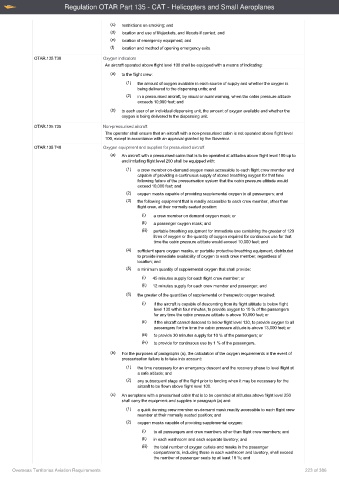Page 223 - Overseas Territories Aviation Requirements Consolidated - Total AOC
P. 223
Regulation OTAR Part 135 - CAT - Helicopters and Small Aeroplanes
(c) restrictions on smoking; and
(d) location and use of lifejackets, and lifecots if carried; and
(e) location of emergency equipment; and
(f) location and method of opening emergency exits.
OTAR.135.730 Oxygen indicators
An aircraft operated above flight level 100 shall be equipped with a means of indicating:
(a) to the flight crew:
(1) the amount of oxygen available in each source of supply and whether the oxygen is
being delivered to the dispensing units; and
(2) in a pressurised aircraft, by visual or aural warning, when the cabin pressure altitude
exceeds 10,000 feet; and
(b) to each user of an individual dispensing unit, the amount of oxygen available and whether the
oxygen is being delivered to the dispensing unit.
OTAR.135.735 Non-pressurised aircraft
The operator shall ensure that an aircraft with a non-pressurised cabin is not operated above flight level
100, except in accordance with an approval granted by the Governor.
OTAR.135.740 Oxygen equipment and supplies for pressurised aircraft
(a) An aircraft with a pressurised cabin that is to be operated at altitudes above flight level 100 up to
and including flight level 250 shall be equipped with:
(1) a crew member on-demand oxygen mask accessible to each flight crew member and
capable of providing a continuous supply of stored breathing oxygen for that time
following failure of the pressurisation system that the cabin pressure altitude would
exceed 10,000 feet; and
(2) oxygen masks capable of providing supplemental oxygen to all passengers; and
(3) the following equipment that is readily accessible to each crew member, other than
flight crew, at their normally-seated position:
(i) a crew member on demand oxygen mask; or
(ii) a passenger oxygen mask; and
(iii) portable breathing equipment for immediate use containing the greater of 120
litres of oxygen or the quantity of oxygen required for continuous use for that
time the cabin pressure altitude would exceed 10,000 feet; and
(4) sufficient spare oxygen masks, or portable protective breathing equipment, distributed
to provide immediate availability of oxygen to each crew member, regardless of
location; and
(5) a minimum quantity of supplemental oxygen that shall provide:
(i) 45 minutes supply for each flight crew member; or
(ii) 12 minutes supply for each crew member and passenger; and
(6) the greater of the quantities of supplemental or therapeutic oxygen required:
(i) if the aircraft is capable of descending from its flight altitude to below flight
level 130 within four minutes, to provide oxygen to 10 % of the passengers
for any time the cabin pressure altitude is above 10,000 feet; or
(ii) if the aircraft cannot descend to below flight level 130, to provide oxygen to all
passengers for the time the cabin pressure altitude is above 13,000 feet; or
(iii) to provide 30 minutes supply for 10 % of the passengers; or
(iv) to provide for continuous use by 1 % of the passengers.
(b) For the purposes of paragraphs (a), the calculation of the oxygen requirements in the event of
pressurisation failure is to take into account:
(1) the time necessary for an emergency descent and the recovery phase to level flight at
a safe altitude; and
(2) any subsequent stage of the flight prior to landing when it may be necessary for the
aircraft to be flown above flight level 100.
(c) An aeroplane with a pressurised cabin that is to be operated at altitudes above flight level 250
shall carry the equipment and supplies in paragraph (a) and:
(1) a quick donning crew member on-demand mask readily accessible to each flight crew
member at their normally seated position; and
(2) oxygen masks capable of providing supplemental oxygen:
(i) to all passengers and crew members other than flight crew members; and
(ii) in each washroom and each separate lavatory; and
(iii) the total number of oxygen outlets and masks in the passenger
compartments, including those in each washroom and lavatory, shall exceed
the number of passenger seats by at least 10 %; and
Overseas Territories Aviation Requirements 223 of 386

